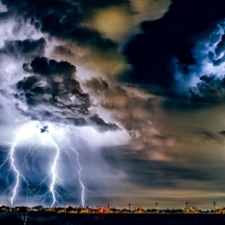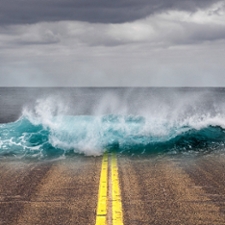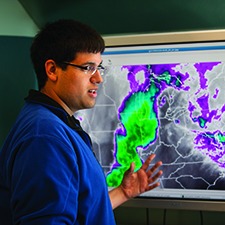Atmospheric and Climate Sciences

Extreme
Weather

EAPS faculty and students use observations and numerical modeling to better understand the physics, predictability and impacts of extreme weather systems, including thunderstorms, tornadoes, and tropical cyclones, and their variability within the climate system.
Climate
Dynamics

The fundamental physics and processes of the regional and large-scale climate system and its variability (such as monsoons, El Niño, and the jet stream), and intraseasonal variability are topics of research by our faculty and students.
Surface-ATMS Interactions

Select EAPS faculty and students study the exchange of energy and matter between the atmosphere and the Earth’s surface, including sea, land, and vegetation.

Atmospheric Science News
Storm Chasing: The Science of Tornadoes
09-04-2024
NEWSTALK — Robin Tanamachi, Associate Professor in the Department of Earth, Atmospheric, and Planetary Sciences at Purdue University, joined host Jonathan McCrea on the FutureProof Podcast to discuss storm chasing and the science of tornadoes.
Why twisters target the United States
09-04-2024
PNAS SCIENCE SESSIONS PODCAST — The Midwestern United States experiences so many tornadoes every year that the region is nicknamed “Tornado Alley.” No other region on Earth comes close in the number of annual tornadoes. So, what’s unique about Tornado Alley? Funing Li and Dan Chavas, of Purdue EAPS, explain why North America produces many tornadoes each year, whereas South America does not.
The Great Salt Lake Is Still Drying Up. Will It Affect Your Health? Yes.
08-30-2024
OUTSIDE — New research found that the Great Salt Lake’s drying lakebed emits tons of greenhouse gasses, threatening the health of those in Utah and beyond. Greenhouse gas emissions are “not directly harmful to health,” says Lisa Welp, associate professor of Earth, Atmospheric and Planetary Sciences at Purdue University, "but they contribute to climate change, which indirectly affects people worldwide."
From lab to lunar and beyond: Check out some of the innovative space research from Purdue University
08-26-2024
PURDUE NEWS — Space scientists are the boots on the ground of extraterrestrial exploration, and Purdue’s researchers rank among the most elite. This collection of impactful news from Purdue University’s space research labs represents the wonder of outer space’s limitless potential. Included in this roundup is research by EAPS faculty Ali Bramson, Alexandria Johnson, Brandon Johnson and Briony Horgan.
The Surprising Factor Making the United States a Tornado Hot Spot
08-23-2024
AGU EOS — The roughness of terrain far upstream of where tornadoes occur can affect their formation. It could be what drives the contrast in tornado activity between North and South America. A new study reveals another key geographic factor: the terrain hundreds of kilometers upwind from where a tornado forms. The authors of the study (from Purdue EAPS), published in the Proceedings of the National Academy of Sciences of the United States of America, found that central North America’s high tornado potential is partly due to the smooth, flat expanse of the Gulf of Mexico and the Caribbean Sea from where easterly winds flow toward the Great Plains.